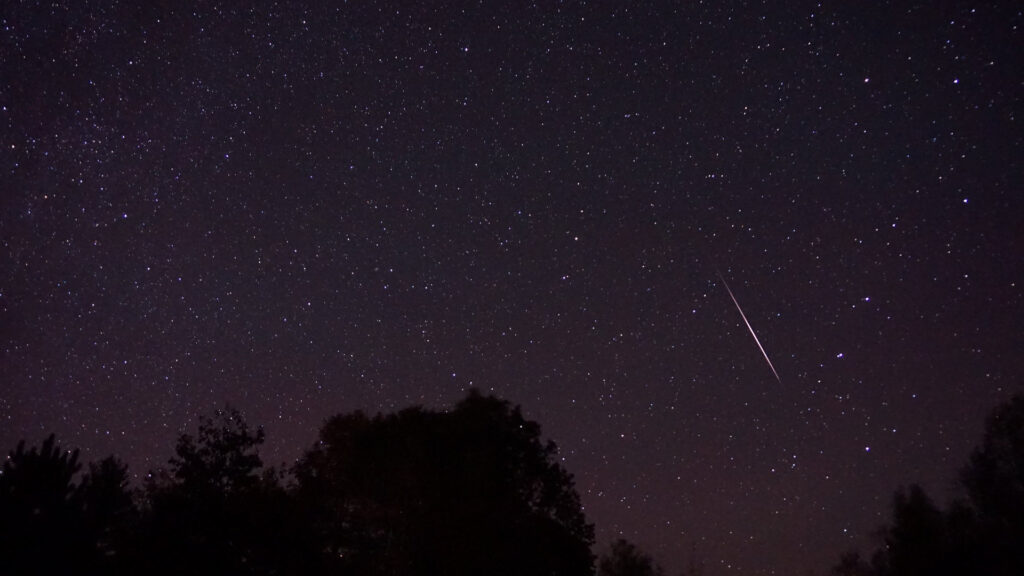What are the next meteor showers to watch in France? Here are all the swarms observable throughout the year 2022.
Have you ever seen shooting stars (or meteors)? Like last year, 2022 offers several opportunities to admire the fine dust vaporized in the atmosphere of our planet, at the origin of this brief luminous phenomenon. The Earth regularly crosses in its orbit trails of tiny grains left by comets or asteroids in their orbits.
The different swarms occur every year, around the same time, with varying intensities. Here’s when to see shooting stars in France in the sky in 2022, to occupy your nights.
The shooting stars of the Quadrantids
Quadrantids swarm peaked overnight January 3-4, 2022. It’s not too late to take advantage: this meteor shower is usually active between December 28 and January 12. There are approximately 80 meteors per hour at peak activity.
It should be observed at the end of the night, before dawn. The radiant, that is to say the area of the sky from which meteors seem to arise, is located between the star Arcturus (constellation Bouvier) and the Pole star (Little Dipper).
The Quadrantids seem to come from an asteroid called 2003 EH1, which takes 5 years to circle the Sun. The swarm owes its name to a constellation that no longer exists, that of the Wall Quadrant.
The shooting stars of the Lyrids
The swarm of the Lyrids knows its maximum activity April 22, 2022. This meteor shower is usually active between April 21 and 22. At the peak of activity, there are about 20 meteors per hour.
The meteors should preferably be observed at the beginning of the night, in the direction of the constellation Lyra, which gives its name to the Lyrides. This requires looking for the “summer triangle”, formed by three bright stars (Vega, Altaïr and Deneb).
The origin of the Lyrids is attributed to a comet, C / 1861 (Thatcher). It takes 415 years to circle the Sun.
The Aquarid Eta Swarm
The Eta aquarids swarm experiences a peak of activity May 6, 2022. These meteors are generally active between April 19 and May 28. We can expect to see between 10 and 20 shooting stars per hour, at the time of peak activity.
This meteor shower gives the impression of emerging from the constellation Aquarius, which one locates by looking for the Large square of Pegasus, formed of four stars. Eta aquarids take their name from a star, Eta Aquarii, located in Aquarius.
Their origin is Halley’s comet (1P / Halley), which takes 76 years to circle the Sun.
The Perseid Swarm
The Perseid swarm is at its peak August 12, 2022. Unfortunately, this year his observation is disturbed by the presence of the full moon. This famous meteor shower is usually active between July 14 and August 24. It’s a heavy rain, with more than 100 meteors visible per hour at the time of the peak.
To see the Perseids, you have to locate the constellation of Perseus (by the way, you will have understood where the name of the swarm comes from), at the bottom of the W formed by the constellation of Cassiopeia.
The origin of the Perseids is a comet, 109 / Swift-Tuttle, which takes 133 years to revolve around the Sun.
The Alpha Auriginides swarm
The swarm ofAlpha Auriginides is at its peak of activity September 1, 2021. It is quite rare to be able to observe this swarm, as already underlined in 2007 by the IMCCE. It is active between August 25 and September 30.
The observation of the Alpha Auriginides requires looking for the constellation of Coachman (Auriga, in Latin), from which the swarm seems to come.
This meteor shower is associated with a comet, C / 1911 N1 Kiess, which approaches the Sun approximately every 200 years.
The Orionids Swarm
The Orionid swarm is at its maximum on October 21, 2022. This meteor shower is usually active between October 2 and November 7. Approximately, there are 15 meteors per hour at the time of peak activity.
Observation is recommended in the second part of the night. It is in the direction of the constellation Orion that it is advisable to look to find the Orionids. With its characteristic 5 stars (including Betelgeuse), it is a basic constellation of the winter sky.
The Orionids come from Halley’s comet, like the Eta aquarids.

The Leonid Swarm
The Leonid swarm knows its peak of activity November 17, 2022. The meteors from this rain are active between November 6 and November 30. During the maximum of the swarm, there are about 15 meteors per hour.
The Leonid radiant is located in the constellation Leo, which rises only in the second half of the night at this time of year. You can spot the Lion from the Big Dipper.
The origin of the Leonids is a comet, named 55P / Tempel-Tuttle. It takes 33 years to orbit the Sun.
The swarm of the Geminids
The year 2022 ends with the Geminids, whose maximum activity is expected December 14. The swarm is usually active between December 4 and 17. There are about 120 meteors per hour at the peak period.
This shower of shooting stars seems to emerge from the constellation Gemini, hence its name, which can be easily identified using the Big Dipper.
The Geminids are associated with 3200 Phaethon, an asteroid that takes more than a year to circle the Sun.
